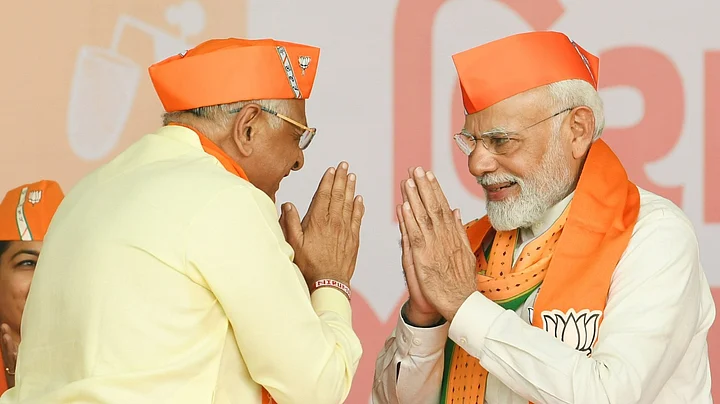Prime Minister Narendra Modi will reportedly be going door-to-door distributing voter slips in Gujarat on 28-29 November and on 2-3 December. He will be addressing eight rallies between 19 and 21 November.
Earlier in November, Modi blessed couples at a mass wedding in Bhavnagar.
Both the Congress and the Aam Aadmi Party have mocked the PM's campaign overdrive in Gujarat as "desperation" or an indication of "BJP's nervousness."
But is it really that simple? Maybe not.
The Quint spoke to several people involved with the Bharatiya Janata Party's (BJP's) campaign in Gujarat and these are some of the reasons that came up for the PM's extensive deployment in the Gujarat campaign.
1. Modi Is the Only Brand for the BJP
Since Anandiben Patel, the BJP's chief ministers in Gujarat haven't quite enjoyed much political heft, be it Vijay Rupani or the present incumbent Bhupendra Patel.
Anandiben Patel, despite her stature, was removed and made governor mainly because her presence at the top was upsetting both the Patidars as well as non-Patidars at a time of caste polarisation in the state. Despite being a Patidar, she became a villain for the community due to the massive crackdown against the Patidar reservation that took place under her. For non-Patels, she was one more symbol of Patidar political domination.
Rupani, a Jain from Rajkot, was a benign figure whose presence at the top didn't upset either of the two sides. Beyond that he didn't have much political significance.
By 2021, Rupani had probably outlived his utility and also lost much of his sheen due to the alleged mismanagement of COVID-19. Therefore he was replaced by Bhupendra Patel. Besides a nod of respect for the Patidar community that had begun to get restive, Bhupendra Patel brings very little to the table. In many parts of the states voters don't even recognise him.
The point here is that the only face is PM Modi. The CM face doesn't matter.
Even Union Home Minister Amit Shah and Gujarat BJP chief CR Patil are both very good strategists but not crowd pullers.
The only brand here is PM Modi and the BJP is trying to find ways of maximising his appeal.
2. Present PM Modi as 'Approachable' and a 'Son of Gujarat'
In the 2017 Assembly elections, the BJP's tally fell below 100 in over two decades. As this was the first Assembly poll after Modi became PM, it was no doubt a dent to his image.
In fact, had it not been for a sweep in urban Gujarat and PM's own involvement in the second phase of campaigning, the party's tally could well have been lower.
This time the BJP wants to emphasise the PM's personal connect with Gujarat – hence the PM's slogan 'We Have Made This Gujarat'.
"The door-to-door campaigning or mass marriages are both ways of showing Modi as 'approachable' and a 'son of Gujarat,'" a Gujarat BJP functionary told The Quint.
3. Paper Over Morbi Tragedy Impact and a Lacklustre State Government
BJP insiders admit that more than the state government's performance, the PM's appeal is the party's main campaign pitch. Be it on job creation, agrarian issues or COVID-19 management, the state government performance has been lacklustre.
The Morbi bridge collapse that killed at least 135 people is the latest and most visible failure of the state government. The contract for the bridge's renovation was granted by the BJP-controlled municipal body.
It is to paper over these failures that the PM's personality is being emphasised in the BJP campaign.
Even in 2017, the PM's campaigning in urban areas and parts of north and central Gujarat bailed BJP out at the last moment.
4. BJP Senses a National Opportunity
In the elections that followed Modi's 2002 victory – 2007, 2012 and 2017 – the BJP's seat share has constantly declined while that of the Congress has been increasing.
This time the BJP sees an opportunity to reverse this trend in Gujarat, especially with Opposition votes likely to be split between Congress and AAP.
The party is hoping for a two thirds majority in the state, something that has eluded it since 2002.
It wants a decisive win in Gujarat as a psychological high in the run-up to the 2024 Lok Sabha elections.
Remember, the 2017 results ended up achieving the reverse – it put the Congress on the path of a brief revival, forming governments in Karnataka, Chhattisgarh, Rajasthan and Madhya Pradesh.
It was only the political impact of the Pulwama attack and Balakot strike that ended up undoing the Congress' gains.
A two thirds majority and decimation of both Congress and AAP is what the BJP wants from this election and it knows that only the 'Modi card' can help achieve that.
(At The Quint, we question everything. Play an active role in shaping our journalism by becoming a member today.)
